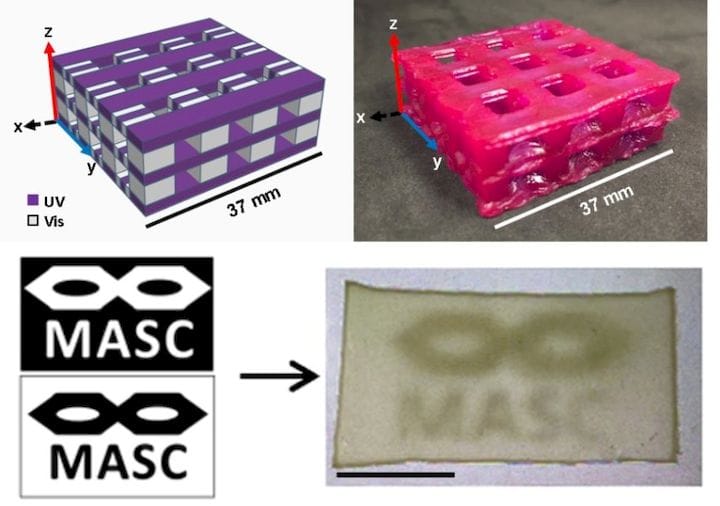![3D printing in two materials with resin [Source: A.J. Boydston and Johanna Schwartz]](https://fabbaloo.com/wp-content/uploads/2020/05/image-asset_img_5eb09af7b5e7f.jpg)
It may soon be possible to 3D print resin objects in more than one material.
3D printing with resin is one of the key processes used in industry today. However, while there are many different types of resins available and upcoming, resin 3D printing, whether from SLA, DLP, or other processes, has a very severe limitation: only a single material can be used.
This limitation would appear obvious when you look at a resin 3D printer setup: there’s a tank of the liquid resin that is illuminated by a light source. Obviously, the liquid resin is a single material; if you put two different kinds of resins together in a tank they would mix together and results would be unpredictable, and likely messy.
Therefore in all commercial resin 3D printers today we see mono-material printing only.
But that could change based on some new research from the University of Wisconsin – Madison.
Their approach is quite unique. The process is comprised of a resin that is actually a mixture of two different materials (monomers), and two different light sources. One light source uses visible light, while the other is ultraviolet light.
When one of the light sources is shining, the corresponding monomers in the exposed resin will solidify. Meanwhile, the other monomers will not.
In their experiment one set of monomers would polymerize into a rigid opaque material, while the other would polymerize into a flexible material. Thus, multi-material resin 3D printing is definitely possible.
Apparently this approach was inspired by old-time chemistry methods that use the “one-pot” method. Here the “pot” is the resin tank itself.
There are a number of thoughts I’m having after hearing of this new discovery.
One is that dual-material 3D printers these days are most often used to provide water soluble support, rather than a second functional material. However, support structures are a bit different in resin machines: to date they are universally made from the model material, and this requires significant post-processing to remove the supports. In many cases the print can be damaged because resin 3D prints tend to be more detailed and thus fragile.
It could be that a common use for this new discovery would be to use the second material option for support structures that are far easier to remove.
Another complication that concerns me is that the resins must be mixed. In a future commercial implementation of this technology, would you buy a resin cartridge that, for example, would be premixed model and support material? Or would you purchase them separately and mix them yourself?
How good a job of mixing would be required? What happens if you don’t mix them sufficiently? Would the specialized machines that print using this approach be required to have some type of mixing system onboard? The answers to these questions will surely be discovered soon.
The more I think about it, the more I think the mixing should be done on the machine itself. Given the increasingly vast number of different resins, and the lack of knowledge of which combinations are desirable, suggests that mixing should be done on the fly.
Another thought is that this technology as developed by the experimenters involves only two materials. Would it be possible to have a three-material system, with a more complicated resin mix, and three different light sources? How many materials could possibly be implemented with this approach? Three? Ten?
I don’t know the answers to those questions but no doubt the researchers will be pondering them as well.
We also don’t know when this technology will appear in commercial products that people can actually use. More than likely there will be a spinoff company to develop it and produce some very interesting 3D printers.
Via ScienceDaily











A research thesis details the incredibly complex world of volumetric 3D printing. We review the highlights.